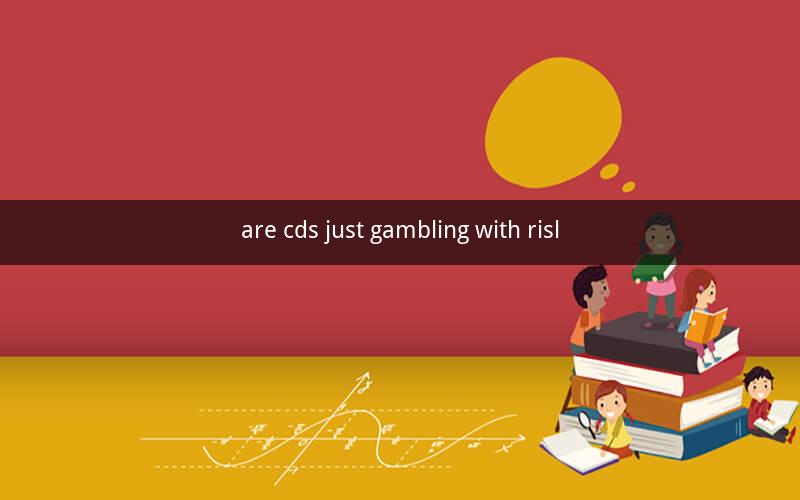
Table of Contents
1. Introduction
2. Understanding CDS
3. The Nature of Risk in CDS
4. Comparing CDS with Gambling
5. Factors Influencing the Risk of CDS
6. The Role of Market Participants
7. The Regulatory Landscape
8. Conclusion
1. Introduction
Credit Default Swaps (CDS) have become a popular financial instrument in recent years, with many investors and market participants considering them as a form of gambling. This article aims to explore the relationship between CDS and gambling, analyzing the risks involved and the factors that contribute to the perception of CDS as a gambling-like activity.
2. Understanding CDS
Credit Default Swaps are financial contracts that allow investors to transfer the credit risk of a debt instrument to another party. In essence, CDS act as insurance against the default of a borrower. When a borrower defaults, the CDS holder receives compensation from the counterparty.
3. The Nature of Risk in CDS
The risk in CDS arises from various factors, including credit risk, market risk, and operational risk. Credit risk refers to the risk that the borrower will default on its debt obligations. Market risk encompasses changes in market conditions, such as interest rates and liquidity. Operational risk involves the risk of loss due to inadequate or failed processes, people, and systems.
4. Comparing CDS with Gambling
CDS can be compared to gambling in several ways. Like gambling, CDS involve betting on the outcome of an event. In gambling, the event is typically the outcome of a game or contest, while in CDS, the event is the default of a borrower. Additionally, both CDS and gambling involve uncertainty and the potential for significant financial gain or loss.
5. Factors Influencing the Risk of CDS
Several factors influence the risk of CDS, including the creditworthiness of the borrower, the liquidity of the CDS market, and the transparency of the underlying assets. A borrower with a lower credit rating is more likely to default, increasing the risk of CDS. Similarly, a lack of liquidity in the CDS market can make it difficult for investors to exit their positions, potentially leading to losses.
6. The Role of Market Participants
Market participants, such as banks, hedge funds, and insurance companies, play a crucial role in the CDS market. These participants engage in CDS transactions to manage their credit risk, speculate on the creditworthiness of borrowers, or hedge their exposure to other financial instruments. However, the actions of these participants can also contribute to the perception of CDS as gambling, particularly when they engage in excessive leverage or speculative trading.
7. The Regulatory Landscape
Regulatory authorities have recognized the potential risks associated with CDS and have implemented measures to mitigate these risks. These measures include the requirement for clearinghouses to facilitate CDS transactions, the imposition of margin requirements, and the implementation of reporting and transparency standards. Despite these efforts, some argue that regulatory measures may not be sufficient to eliminate the gambling-like aspects of CDS.
8. Conclusion
Credit Default Swaps can be seen as a form of gambling due to their similarities with gambling in terms of betting on the outcome of an event and the potential for significant financial gain or loss. However, the risks involved in CDS are complex and influenced by various factors, including credit risk, market risk, and operational risk. While regulatory measures have been implemented to mitigate these risks, the perception of CDS as gambling persists among some market participants.
Questions and Answers:
1. What is a Credit Default Swap (CDS)?
A CDS is a financial contract that allows investors to transfer the credit risk of a debt instrument to another party.
2. What are the main risks associated with CDS?
The main risks associated with CDS include credit risk, market risk, and operational risk.
3. How do CDS differ from gambling?
CDS differ from gambling in that they involve betting on the outcome of an event related to credit risk, whereas gambling typically involves betting on the outcome of a game or contest.
4. What factors influence the risk of CDS?
The risk of CDS is influenced by the creditworthiness of the borrower, the liquidity of the CDS market, and the transparency of the underlying assets.
5. How do market participants contribute to the perception of CDS as gambling?
Market participants, such as banks and hedge funds, can contribute to the perception of CDS as gambling through excessive leverage and speculative trading.
6. What regulatory measures have been implemented to mitigate the risks associated with CDS?
Regulatory measures include the requirement for clearinghouses, margin requirements, and reporting and transparency standards.
7. Why do some argue that regulatory measures may not be sufficient to eliminate the gambling-like aspects of CDS?
Some argue that regulatory measures may not be sufficient because they may not address the underlying factors that contribute to the perception of CDS as gambling, such as excessive leverage and speculative trading.
8. Can CDS be used for hedging purposes?
Yes, CDS can be used for hedging purposes to manage credit risk and protect against the default of a borrower.
9. How do CDS affect the financial markets?
CDS can affect the financial markets by influencing the pricing of credit risk and impacting the liquidity of financial instruments.
10. What is the role of clearinghouses in the CDS market?
Clearinghouses facilitate CDS transactions by acting as intermediaries between the buyer and seller, ensuring that both parties fulfill their obligations.